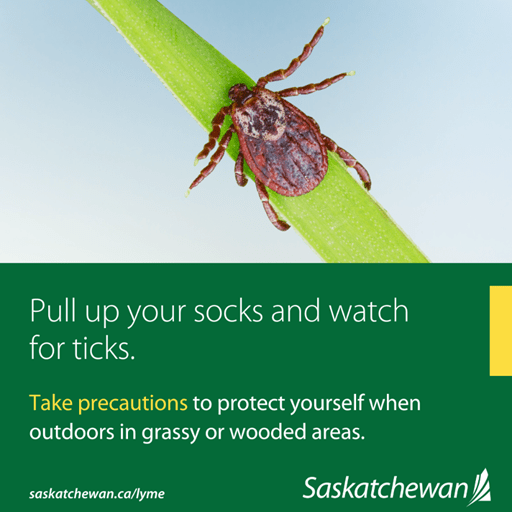Released on May 19, 2023
Saskatchewan residents are being reminded to take precautions to avoid tick bites as warmer weather begins.
With many people heading outside over the long weekend, the Ministry of Health would like to remind you that ticks are often found in tall grass, brush, or wooded areas and will latch onto people or pets who brush up against them.
"People should check themselves, their children and their pets for ticks after spending time outdoors," Saskatchewan Deputy Chief Medical Health Officer Dr. Julie Kryzanowski said. "Taking precautions, like pulling your socks up over your pant legs and using effective insect repellents, will reduce the risk of tick bites."
The American dog tick, or wood tick, is the most common tick species in Saskatchewan. They are most active from spring to early summer and cannot transmit Lyme disease to people.
The risk of exposure to Lyme disease, caused by blacklegged ticks, is low in Saskatchewan.
The Ministry of Health collaborates with the University of Saskatchewan and eTick to identify ticks collected in Saskatchewan. In 2022, 1,308 ticks were identified in the province and only 17 were blacklegged ticks. Seven of these were submitted for testing and none of them tested positive for the bacteria that causes Lyme disease.

To date, no established populations of blacklegged ticks have been detected in Saskatchewan through active surveillance efforts. People should be prepared if they are traveling to other provinces or countries where there are established populations of blacklegged ticks that can transmit Lyme disease.
To prevent tick bites:
- Wear light-coloured clothes so ticks can be easily seen.
- Wear pants, long-sleeved shirts, and shoes that do not expose your bare feet.
- Pull socks over your pant legs to prevent ticks from crawling up your legs.
- Use insect repellents that contain DEET or Icaridin. Apply repellent to clothes as well as your skin (under sunscreen). Always read and follow the directions on the label. Some repellents may have age restrictions.
- In Canada, clothing that has been treated with the insecticide permethrin has been approved for use by people over the age of 16.
- Shower or bathe as soon as possible after being outside to wash off loose ticks.
- Do full-body tick checks as soon as possible after being outside on yourself, your children, and pets.
If you find a tick attached to your skin or on your pet:
- Carefully remove it with fine-tipped tweezers and grasp the tick's mouthparts as close to the skin as possible.
- For a video demonstration on how to remove a tick, please visit saskatchewan.ca/lyme.
- Do not put Vaseline, gasoline, or other harmful substances on an attached tick.
- You may also submit photos of the tick using the eTick system (www.etick.ca) Please keep ticks in a secure container until you receive the identification results as you may be requested to submit them by mail for further study. Ticks should not be submitted by mail unless requested.
- Ticks can be euthanized by placing them in a bag and storing them in the freezer 24 hours.
For more information on ticks and Lyme disease, including how to submit a tick for identification and testing, visit saskatchewan.ca/lyme or https://research-groups.usask.ca/ticks/#Passivesurveillance.
-30-
For more information, contact:
Health
Media Relations
Regina
Phone: 306-787-4083
Email: media@health.gov.sk.ca
